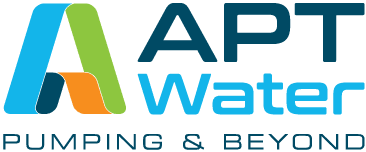There are many reasons why a breakdown at a sewerage pump station is bad news. They can cause environmental problems due to sewerage build-up and overflows. A breakdown situation can often lead to more damage and injuries than regular maintenance tasks. Thirdly, a breakdown repair is more expensive than routine and preventative maintenance.
Maintaining sewerage pump stations at an appropriate level is crucial. But what exactly does that mean and how do you get started?
We have years of experience in wastewater treatment in Perth, from sewage pumps to bore pumps, and can offer the benefits of pre-engineered, modularised designs that allow for the simple installation of a sewage treatment system on-site.
For expert advice, contact APT Water regarding sewerage pump station maintenance.
Sewerage pump station maintenance is vital
If it’s not fixed, even the smallest deviation from normal service can be a problem. If your pump is constantly tripping the circuit breaker, it could be a sign that it is already inefficient and drawing too much power.
A pump that becomes too noisy can also indicate a serious problem. Repairs will be more costly if a pump is allowed to stop working than if they addressed earlier. This can also cause more downtime than regular maintenance and servicing would.
Sewerage pump stations treat very dirty streams. The system can be blocked by solid waste, causing problems with flow and pump damage. Pump seals and packaging are also subject to extreme conditions, leading to leakage and odour complaints.
Level switches can also become inoperable due to sludge build-up at a sewerage pump station. This can cause the pump to continue running even though it should be shutting down, which could prove dangerous. The pump can cause vibration and cavitation if the level drops below its designed minimum. Overuse can also cause the pump to overheat, which can accelerate the pump’s failure.
What tasks should be included in a maintenance program?
It is important to remove sewerage pumps from a pump station every 1,000 hours. Before removing the pump from a pump station, it must first be electrically isolated. Use only tracks and chains for pump removal, taking great care when doing so as this can cause serious injuries. You can do various tasks on the chamber, piping and pump, but other tasks require the pump to be removed.
You should drain the sludge from your pump station chamber. The walls should be washed down at the same moment to get rid of all the debris. Flush out all inline and non-return valves and suction lines. Once the chamber has been cleaned, verify that the level switches are working properly and inspect the piping and walls for any signs of corrosion.
A maintenance professional should inspect the performance of the sewerage pump. These are just a few of the basic tasks that should be added to your schedule.
- Verify the oil’s condition – the presence of water in the oil may indicate a leakage that will require additional maintenance. Check the oil level and top it up if needed.
- The motor housing inspection port should be opened – a leaky motor housing can be identified by large amounts of water, however, oil can also indicate a failure of the seal. Based on your observations, take the appropriate actions.
- The clearance between the knife’s blade and the cutting disc should be checked – wear can cause this clearance to become excessive, so adjust the clearance to within the design specifications.
Check pump components like impeller condition, stuffing box, shafts, sleeves, wear rings or plates. Cavitation problems should be addressed if there is any evidence of impeller pitting.
Many sewerage pump stations require similar maintenance requirements. There may be a greater need to intervene due to larger amounts of sewerage. Systems with larger volumes of sewerage may have complex control systems and dual switching pump systems, which can lead to additional checks.
Basic troubleshooting of sewerage pump stations
Minor or major faults can cause the stoppage of sewerage pump stations. These are some basic tips to troubleshoot sewerage pump station problems.
| Symptom | Possible Cause |
| Pump won’t start |
|
| Pump won’t stop |
|
| Pump keeps switching on and off |
|
| Motor current too high |
|
| Low flow |
|
| High level alarm |
|
Contact APT Water for expert advice
APT Water has over 15 years of experience in wastewater treatment from sewage pumps to bore pumps in Perth in Western Australia. We provide maintenance services and supply sewerage pump stations. You can trust our technical experts to ensure the proper performance and maintenance for your sewerage pump station. We help you comply with regulations and minimise your impact on the local community.
Contact our expert today to arrange a consultation.



